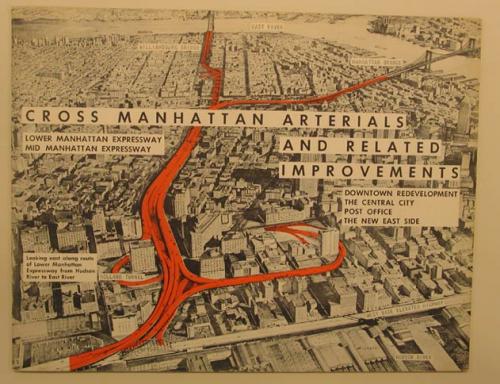Anyone seen any of the three museum shows in New York on Robert Moses, the colossus of urban planning? I myself have not, seeing as how I live 3,000 miles away from them. To recap: highly controversial figure, built many public works from the 1920s through the 1960s, in the end wanted to destroy neighborhoods to build freeways, ultimately brought low by grassroots organizing and the sainted Jane Jacobs via her book The Death and Life of Great American Cities.The exhibits have gotten a lot of ink in the New York press and the planning press. An excerpt from Ada Louise Huxtable's review in the Wall Street Journal today, and other rantings, after the jump.
 Anyone seen any of the three museum shows in New York on Robert Moses, the colossus of urban planning? I myself have not, seeing as how I live 3,000 miles away from them. To recap: highly controversial figure, built many public works from the 1920s through the 1960s, in the end wanted to destroy neighborhoods to build freeways, ultimately brought low by grassroots organizing and the sainted Jane Jacobs via her book The Death and Life of Great American Cities.
Anyone seen any of the three museum shows in New York on Robert Moses, the colossus of urban planning? I myself have not, seeing as how I live 3,000 miles away from them. To recap: highly controversial figure, built many public works from the 1920s through the 1960s, in the end wanted to destroy neighborhoods to build freeways, ultimately brought low by grassroots organizing and the sainted Jane Jacobs via her book The Death and Life of Great American Cities.
The exhibits have gotten a lot of ink in the New York press and the planning press. An excerpt from Ada Louise Huxtable's review in the Wall Street Journal today, and other rantings, after the jump.
It was obvious that those who remembered the midnight bulldozers sent into Central Park to rip up a playground for more parking for the Tavern on the Green, or the road that would have bisected Washington Square Park with high-speed traffic-both opposed by "a bunch of mothers"-were still clinging to Moses' image of audacious evil. Some (there are still a few of us) who manned the ramparts against his most damaging interventions and were submitted to his most creative villifications were resisting his canonization. The fight to kill the infamous Lower Manhattan Expressway that would have destroyed SoHo, much of the Cast Iron District, and parts of Chinatown, Little Italy and the West Village (Moses insisted there was nothing to save) is a subject that defies detachment.
Well...lookit me! I'm detached!
Seriously, aren't you people tired of having the Moses/Jacobs/Mumford argument? I mean, it's 50 years old. And it's really the same argument as the one the New Urbanists wage, or the big-box developers wage: It's between giving people what they need and giving people what they want.

(And, just to add some shades of grey to my oversimplification, it's about recognizing the difference, and knowing when to follow which impulse.)
No amount of involving the public in planning decisions-no matter how fancy the technology is that you use-will change the fact that for most folks, public transit and walkable neighborhoods are fantastic ideas for other people. I hate my twice-daily driving commute; I hate trying to figure out how to get my kid to day care and still ride the (infrequent, uncomfortable) bus more. I hate shopping at Target/CostCo/Home Depot; I hate figuring out how to get 36 rolls of toilet paper and seven eight-foot-long redwood 2x4s home more.
And as long as I'm ranting about what I hate, I also hate the idea of razing the world's best neighborhoods for freeways. But I also also hate Jacob's idealized version of the West Village as a place that human beings of all ages and incomes can live in comfortable harmony. It was, frankly, a lie, from its assumption that a even a small family of professionals like mine can afford to live anywhere near a downtown to it's assertion that a life there was anything approaching convenient.
So, what do I want?
Um...let me think about it and get back to you.
Meanwhile, if anyone goes to see the Moses shows, email me a few pictures at adam underscore rogers at wired dot com. I'll post them in another blog entry.

Planetizen Federal Action Tracker
A weekly monitor of how Trump’s orders and actions are impacting planners and planning in America.

Chicago’s Ghost Rails
Just beneath the surface of the modern city lie the remnants of its expansive early 20th-century streetcar system.

Amtrak Cutting Jobs, Funding to High-Speed Rail
The agency plans to cut 10 percent of its workforce and has confirmed it will not fund new high-speed rail projects.

Ohio Forces Data Centers to Prepay for Power
Utilities are calling on states to hold data center operators responsible for new energy demands to prevent leaving consumers on the hook for their bills.

MARTA CEO Steps Down Amid Citizenship Concerns
MARTA’s board announced Thursday that its chief, who is from Canada, is resigning due to questions about his immigration status.

Silicon Valley ‘Bike Superhighway’ Awarded $14M State Grant
A Caltrans grant brings the 10-mile Central Bikeway project connecting Santa Clara and East San Jose closer to fruition.
Urban Design for Planners 1: Software Tools
This six-course series explores essential urban design concepts using open source software and equips planners with the tools they need to participate fully in the urban design process.
Planning for Universal Design
Learn the tools for implementing Universal Design in planning regulations.
Caltrans
City of Fort Worth
Mpact (founded as Rail~Volution)
City of Camden Redevelopment Agency
City of Astoria
City of Portland
City of Laramie


























